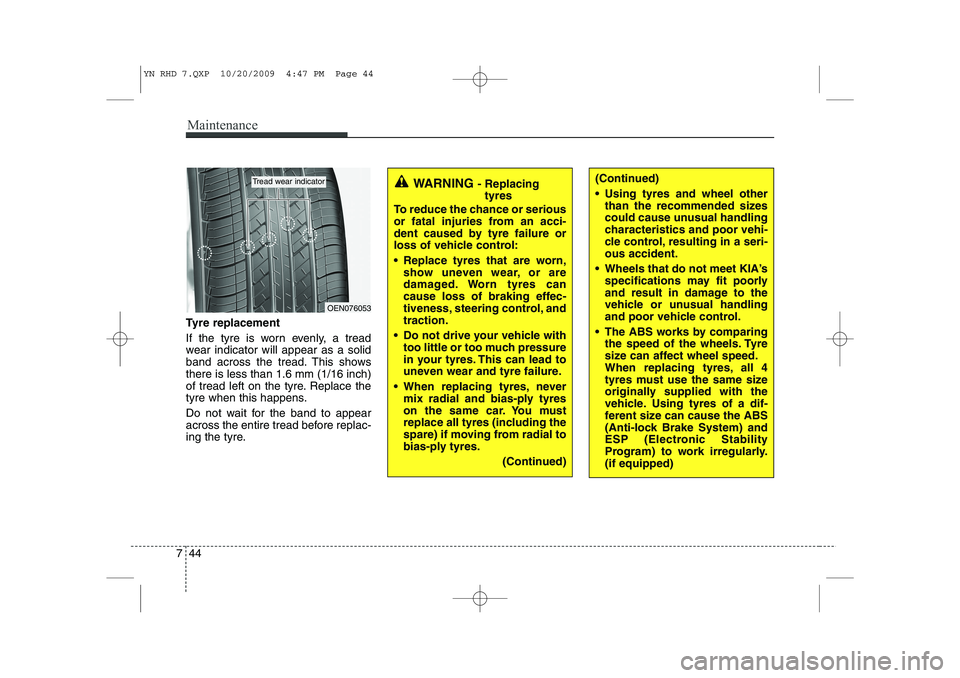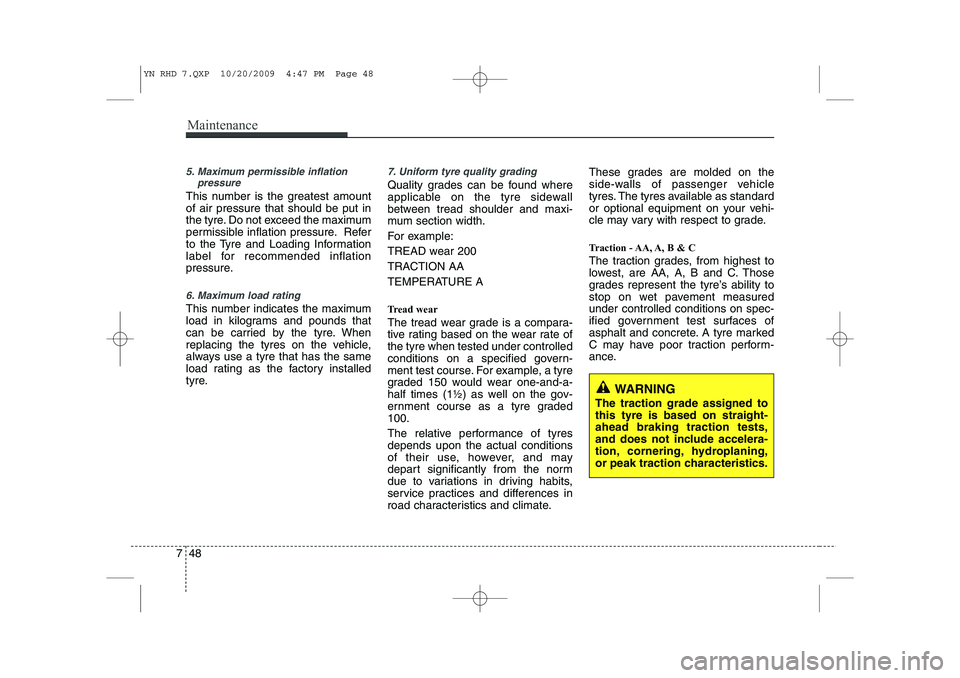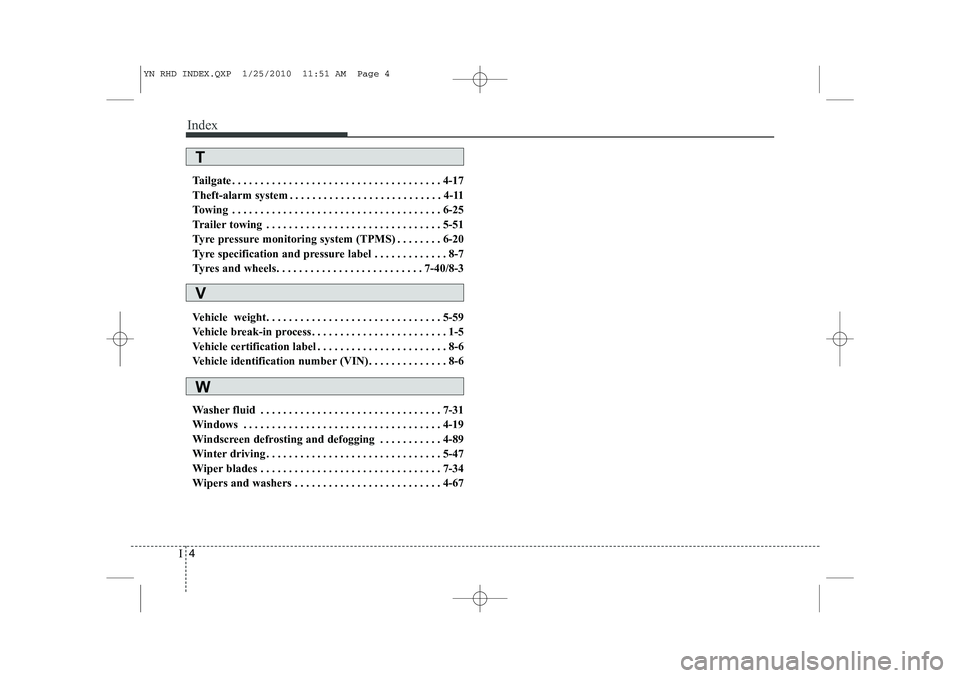Page 682 of 761

Maintenance
42
7
Remove the valve cap from the tyre
valve stem. Press the tyre gage firm-
ly onto the valve to get a pressure
measurement. If the cold tyre infla-tion pressure matches the recom-mended pressure on the tyre and
loading information label, no further
adjustment is necessary. If the pres-
sure is low, add air until you reachthe recommended amount.
If you overfill the tyre, release air by pushing on the metal stem in the
centre of the tyre valve. Recheck the
tyre pressure with the tyre gage. Be
sure to put the valve caps back on
the valve stems. They help prevent
leaks by keeping out dirt and mois-
ture. Tyre rotation
To equalize tread wear, it is recom- mended that the tyres be rotated
every 12,000 km (7,500 miles) or
sooner if irregular wear develops.
During rotation, check the tyres for
correct balance.
When rotating tyres, check for
uneven wear and damage. Abnormal
wear is usually caused by incorrect
tyre pressure, improper wheel align-
ment, out-of-balance wheels, severe
braking or severe cornering. Look for
bumps or bulges in the tread or side
of tyre. Replace the tyre if you find
either of these conditions. Replace
the tyre if fabric or cord is visible.
After rotation, be sure to bring thefront and rear tyre pressures to spec-
ification and check lug nut tightness.
Refer to “Tyre and wheels” in section 8.
WARNING
Inspect your tyres frequently for proper inflation as well as
wear and damage. Always use
a tyre pressure gauge.
Tyres with too much or too lit- tle pressure wear unevenly
causing poor handling, loss of
vehicle control, and suddentyre failure leading to acci-
dents, injuries, and even death.The recommended cold tyre
pressure for your vehicle can
be found in this manual and onthe tyre label located on the
driver's side centre pillar.
Worn tyres can cause acci- dents. Replace tyres that are
worn, show uneven wear, or
are damaged.
Remember to check the pres- sure of your spare tyre. KIA
recommends that you check
the spare every time you
check the pressure of the
other tyres on your vehicle.
YN RHD 7.QXP 10/20/2009 4:47 PM Page 42
Page 684 of 761

Maintenance
44
7
Tyre replacement
If the tyre is worn evenly, a tread
wear indicator will appear as a solid
band across the tread. This showsthere is less than 1.6 mm (1/16 inch)
of tread left on the tyre. Replace the
tyre when this happens.
Do not wait for the band to appear
across the entire tread before replac-
ing the tyre.
OEN076053
Tread wear indicatorWARNING - Replacing
tyres
To reduce the chance or serious
or fatal injuries from an acci-
dent caused by tyre failure or
loss of vehicle control:
Replace tyres that are worn, show uneven wear, or are
damaged. Worn tyres can
cause loss of braking effec-
tiveness, steering control, andtraction.
Do not drive your vehicle with too little or too much pressure
in your tyres. This can lead to
uneven wear and tyre failure.
When replacing tyres, never mix radial and bias-ply tyres
on the same car. You must
replace all tyres (including the
spare) if moving from radial to
bias-ply tyres.
(Continued)(Continued)
Using tyres and wheel otherthan the recommended sizes
could cause unusual handling
characteristics and poor vehi-
cle control, resulting in a seri-ous accident.
Wheels that do not meet KIA’s specifications may fit poorly
and result in damage to the
vehicle or unusual handling
and poor vehicle control.
The ABS works by comparing the speed of the wheels. Tyre
size can affect wheel speed.
When replacing tyres, all 4
tyres must use the same size
originally supplied with the
vehicle. Using tyres of a dif-
ferent size can cause the ABS
(Anti-lock Brake System) and
ESP (Electronic Stability
Program) to work irregularly.(if equipped)
YN RHD 7.QXP 10/20/2009 4:47 PM Page 44
Page 688 of 761

Maintenance
48
7
5. Maximum permissible inflation
pressure
This number is the greatest amount of air pressure that should be put in
the tyre. Do not exceed the maximum
permissible inflation pressure. Refer
to the Tyre and Loading Information
label for recommended inflation
pressure.
6. Maximum load rating
This number indicates the maximum
load in kilograms and pounds that
can be carried by the tyre. When
replacing the tyres on the vehicle,
always use a tyre that has the same
load rating as the factory installed
tyre.
7. Uniform tyre quality grading
Quality grades can be found where
applicable on the tyre sidewall
between tread shoulder and maxi-
mum section width.
For example:
TREAD wear 200
TRACTION AA
TEMPERATURE A
Tread wear
The tread wear grade is a compara-
tive rating based on the wear rate ofthe tyre when tested under controlled
conditions on a specified govern-
ment test course. For example, a tyre
graded 150 would wear one-and-a-
half times (1½) as well on the gov-
ernment course as a tyre graded100.
The relative performance of tyres depends upon the actual conditions
of their use, however, and may
depart significantly from the norm
due to variations in driving habits,
service practices and differences in
road characteristics and climate. These grades are molded on the
side-walls of passenger vehicle
tyres. The tyres available as standard
or optional equipment on your vehi-
cle may vary with respect to grade.
Traction - AA, A, B & C
The traction grades, from highest to
lowest, are AA, A, B and C. Those
grades represent the tyre’s ability to
stop on wet pavement measuredunder controlled conditions on spec-
ified government test surfaces of
asphalt and concrete. A tyre marked
C may have poor traction perform-
ance.
WARNING
The traction grade assigned to this tyre is based on straight-ahead braking traction tests,
and does not include accelera-
tion, cornering, hydroplaning,
or peak traction characteristics.
YN RHD 7.QXP 10/20/2009 4:47 PM Page 48
Page 718 of 761
8
Dimensions / 8-2 Bulb wattage / 8-2
Tyres and wheels / 8-3Recommended lubricants and capacities / 8-4
Vehicle identification number (VIN) / 8-6
Vehicle certification label / 8-6
Tyre specification and pressure label / 8-7
Engine number / 8-7
Specifications & Consumer information
YN RHD 8.QXP 10/20/2009 4:53 PM Page 1
Page 720 of 761
83
Specifications & Consumer information
TYRES AND WHEELS
* Normal load : Up to 2 persons
CAUTION
When replacing tyres, use the same size originally suppliedwith the vehicle.
Using tyres of a different sizecan damage the related parts ormake it work irregularly.
Front Rear Front Rear
195/65R15 6.0J×15 2.2 2.2 2.5 2.5
205/55R16 6.0J×16 (32, 220) (32, 220) (35, 250) (35, 250)
205/50R17 6.5J×17
T125/80D15 4.0T×15 4.2 4.2 4.2 4.2
(60, 420) (60, 420) (60, 420) (60, 420)
Full size tyre
Compact spare tyre (if equipped) Normal load
*1
Maximum load Wheel lug nut torque
kg•m (lbft, Nm)
9~11
(65~79, 88~107)
Item
Tyre
size Wheel
size Cold tyre inflation pressure
bar (psi,kPa)
YN RHD 8.QXP 10/20/2009 4:53 PM Page 3
Page 724 of 761
87
Specifications & Consumer information
The tyres supplied on your new vehicle
are chosen to provide the best perform-
ance for normal driving.
The tyre label located on the driver's side
centre pillar gives the tyre pressures rec-
ommended for your car.The engine number is stamped on the
engine block as shown in the drawing.
OYN089003R
TYRE SPECIFICATION AND PRESSURE LABEL
OYN089006
Petrol engine
OYN089007
ENGINE NUMBER
Diesel engine
YN RHD 8.QXP 10/20/2009 4:53 PM Page 7
Page 728 of 761

Index
4
I
Tailgate . . . . . . . . . . . . . . . . . . . . . . . . . . . . . . . . . . . . . 4-17
Theft-alarm system . . . . . . . . . . . . . . . . . . . . . . . . . . . 4-11
Towing . . . . . . . . . . . . . . . . . . . . . . . . . . . . . . . . . . . . . 6-25
Trailer towing . . . . . . . . . . . . . . . . . . . . . . . . . . . . . . . 5-51
Tyre pressure monitoring system (TPMS) . . . . . . . . 6-20
Tyre specification and pressure label . . . . . . . . . . . . . 8-7
Tyres and wheels. . . . . . . . . . . . . . . . . . . . . . . . . . 7-40/8-3
Vehicle weight. . . . . . . . . . . . . . . . . . . . . . . . . . . . . . . 5-59
Vehicle break-in process . . . . . . . . . . . . . . . . . . . . . . . . 1-5
Vehicle certification label . . . . . . . . . . . . . . . . . . . . . . . 8-6
Vehicle identification number (VIN). . . . . . . . . . . . . . 8-6
Washer fluid . . . . . . . . . . . . . . . . . . . . . . . . . . . . . . . . 7-31
Windows . . . . . . . . . . . . . . . . . . . . . . . . . . . . . . . . . . . 4-19
Windscreen defrosting and defogging . . . . . . . . . . . 4-89
Winter driving . . . . . . . . . . . . . . . . . . . . . . . . . . . . . . . 5-47
Wiper blades . . . . . . . . . . . . . . . . . . . . . . . . . . . . . . . . 7-34
Wipers and washers . . . . . . . . . . . . . . . . . . . . . . . . . . 4-67
T
V
W
YN RHD INDEX.QXP 1/25/2010 11:51 AM Page 4